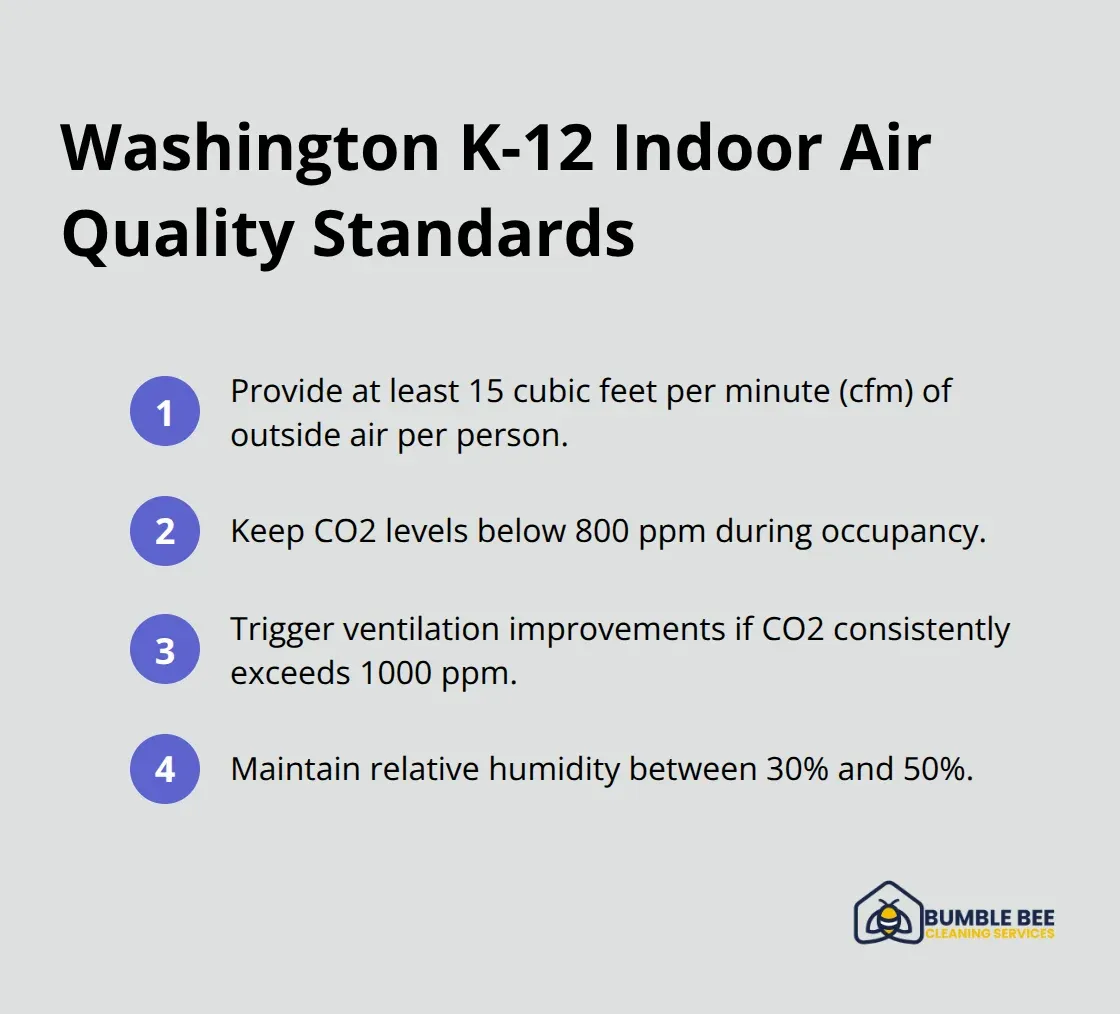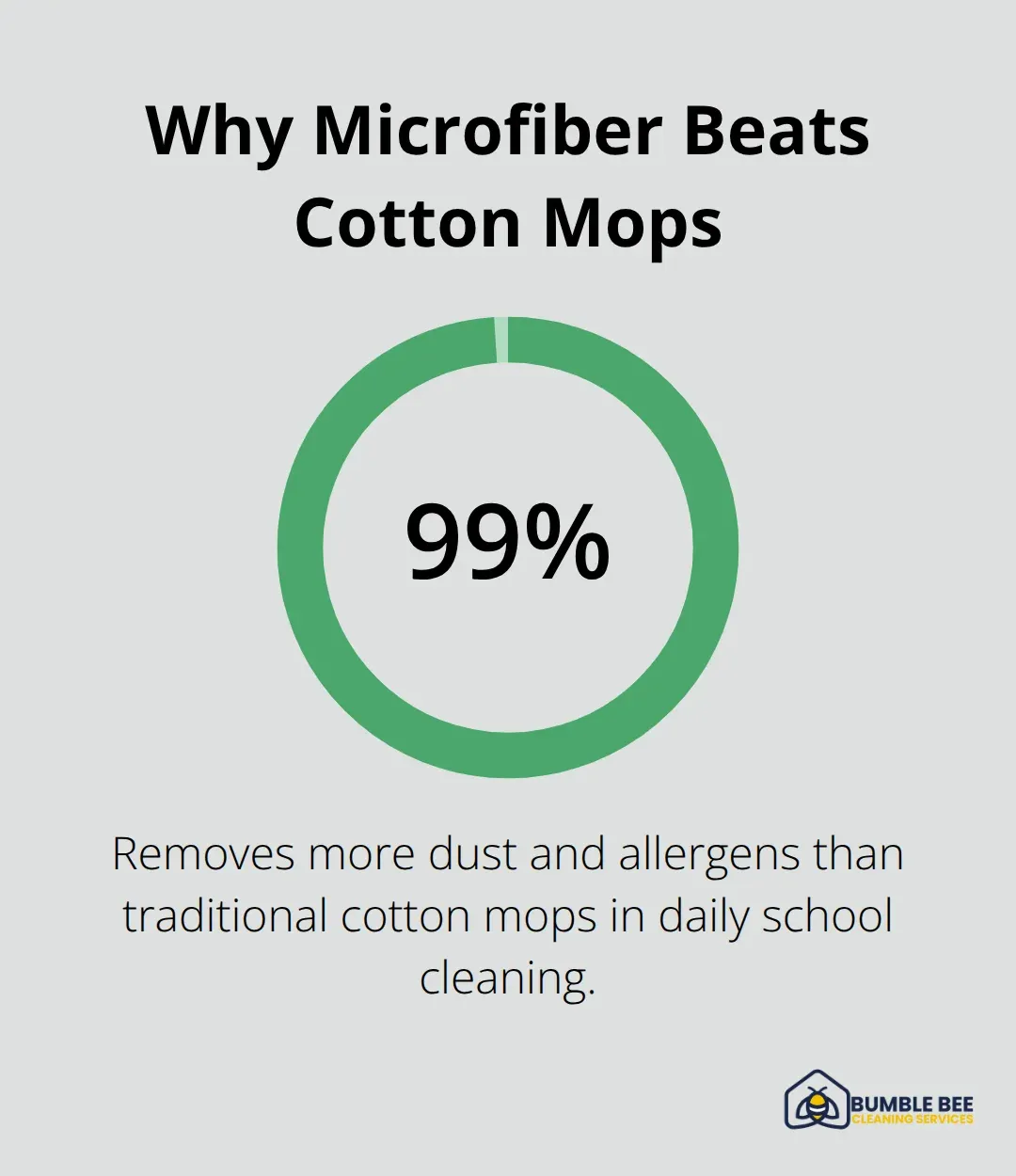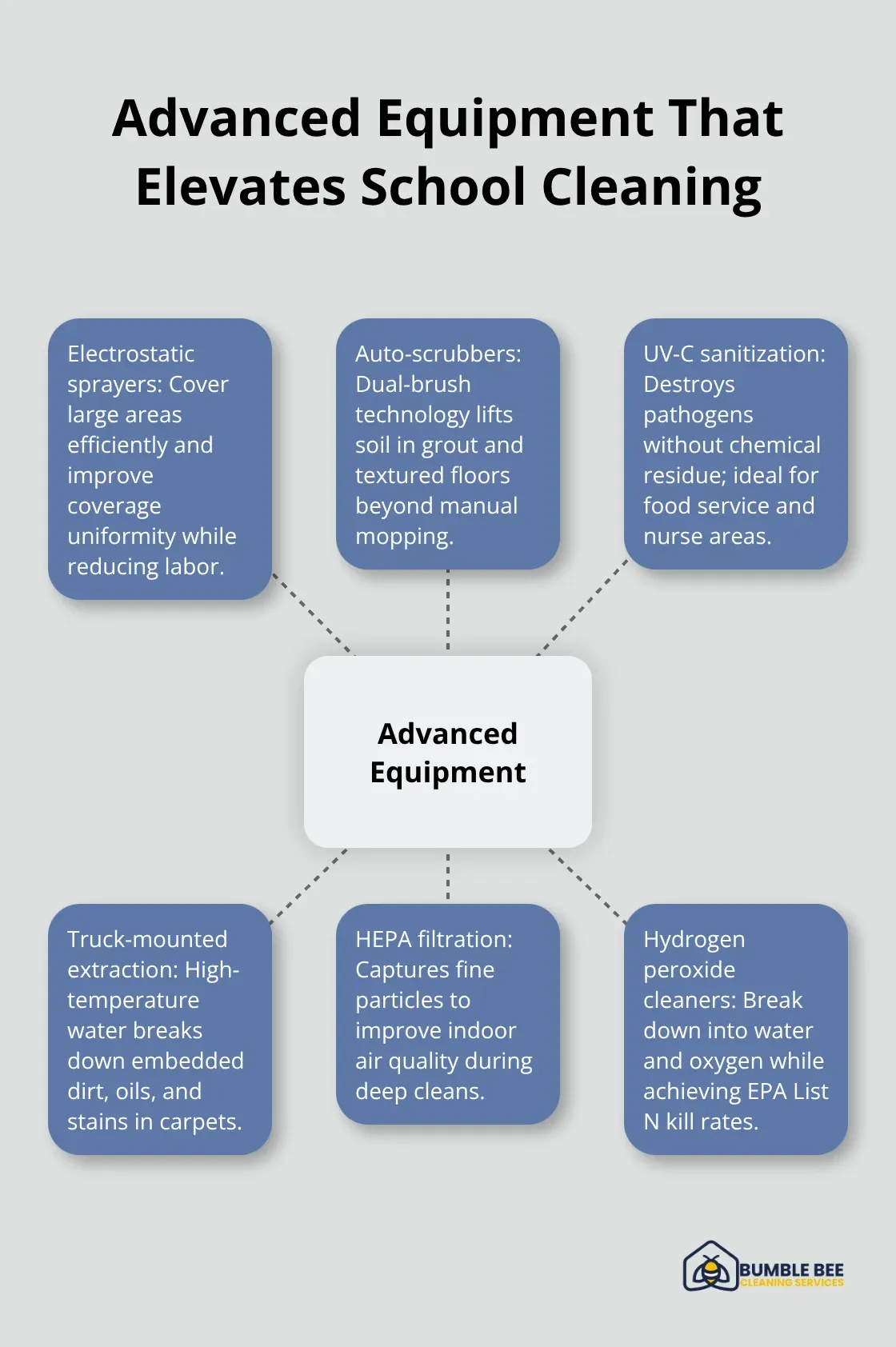Seattle schools face unique cleaning challenges that many administrators overlook. From constant rain tracking mud through hallways to managing allergens in crowded classrooms, maintaining proper hygiene standards requires more than basic janitorial work.
We at Bumble Bee Cleaning Services see firsthand how inadequate school cleaning affects student health and learning environments. Modern educational facilities need comprehensive cleaning protocols that go beyond surface-level maintenance.
Current Seattle School Cleaning Standards and Requirements
Washington State Health Department sets specific ventilation requirements for educational facilities. Schools must provide at least 15 cubic feet per minute of fresh outside air per person. Carbon dioxide levels must stay below 800 ppm, and levels that consistently exceed 1000 ppm trigger immediate ventilation improvements. The state requires relative humidity between 30-50% to reduce respiratory irritation and allergy issues among students and staff.

Seattle District Protocols Define Daily Operations
Seattle Public Schools District requires custodial staff to address water leaks within 24 hours to prevent mold growth. The district mandates MERV 13 or higher filters in all ventilation systems and requires continuous ventilation operation during school hours and custodial work. Staff must dispose of food waste immediately in covered containers, and schools must implement integrated pest management strategies to prevent rodent and cockroach infestations.
High-touch surfaces including doorknobs, desks, and shared equipment need daily disinfection with EPA-approved products. Teachers cannot perform these disinfection tasks (only trained custodial staff can handle this responsibility).
OSHA Standards Protect School Workers
OSHA safety standards require schools to provide proper protective equipment for custodial staff who handle chemical products. Staff must receive training on hazardous material handling and emergency response procedures. Schools must maintain proper ventilation during operations and keep safety data sheets for all chemicals used on premises.
The regulations prohibit untrained personnel from performing disinfection tasks – only certified custodial staff can handle these responsibilities safely.
Compliance Gaps Create Health Risks
Many Seattle schools struggle to meet these comprehensive standards consistently. Budget constraints often limit the frequency of deep maintenance, while high student populations put extra strain on facilities. Poor ventilation systems in older buildings make it difficult to maintain required air quality levels, and inadequate staffing can delay response times for water damage and pest issues.
These compliance gaps directly impact student health and academic performance, making professional support increasingly necessary for schools that want to maintain proper standards year-round.
Common Cleaning Challenges in Seattle Schools
Seattle’s constant rainfall creates a perfect storm for school cleanliness challenges that most districts underestimate. Students track more dirt and moisture into buildings during the rainy season compared to dry climates, according to facility management data. This moisture doesn’t just create visible mud trails – it penetrates deep into carpet fibers and creates bacterial growth in high-traffic areas like main entrances, cafeterias, and gymnasium floors.
Heavy Traffic Zones Demand Daily Deep Attention
Main hallways in typical Seattle schools see over 2,000 student passages daily during class changes. These corridors require specialized approaches that go beyond standard mopping. Microfiber systems remove 99% more dust and allergens than traditional cotton mops, but most schools still rely on outdated equipment that simply redistributes contaminants.

Entryway mats should extend at least 12 feet into buildings to capture maximum moisture, yet many Seattle schools use inadequate 4-foot systems that leave floors vulnerable to water damage and slip hazards.
Indoor Air Quality Battles Year-Round Allergens
Seattle’s damp climate keeps indoor humidity levels consistently above the recommended 50% threshold, which creates ideal conditions for dust mites and mold spores. Schools with poor ventilation systems show CO2 readings that spike during peak occupancy – above safe levels recommended by ASHRAE. The combination of wet weather, inadequate air circulation, and high student density means allergen concentrations in Seattle classrooms often exceed healthy limits compared to properly maintained facilities.
Traditional Methods Fall Short
Regular surface work with microfiber cloths removes significantly more allergens than spray-and-wipe methods, yet many schools continue to use less effective traditional approaches that leave students and staff exposed to respiratory irritants. Standard cotton mops push dirt around rather than capture it (which explains why floors look clean but air quality remains poor). These outdated practices become especially problematic when combined with Seattle’s unique environmental challenges that demand more sophisticated solutions.
Professional Cleaning Solutions for Educational Facilities
School breaks provide the only opportunity for comprehensive facility restoration that addresses years of accumulated contamination. Summer cleaning projects use truck-mounted extraction systems that provide deep cleaning through high-temperature water that breaks down dirt, oils, and stains deep within carpet fibers. Steam cleaning at high temperatures eliminates bacteria and allergens that survive standard cleaning methods, while HEPA filtration systems during these deep cleans capture particles that contribute to poor air quality throughout the school year.
Advanced Equipment Transforms Results
Professional-grade electrostatic sprayers cover large areas efficiently compared to traditional methods, which reduces labor costs while it improves coverage uniformity. Auto-scrubbers with dual-brush technology remove soil buildup in grout lines and textured surfaces that manual mopping cannot reach.

UV-C sanitization systems destroy pathogens on surfaces without chemical residue, which makes them ideal for food service areas and nurse stations where chemical sensitivity concerns limit traditional disinfection options.
Green Products Deliver Superior Performance
Third-generation hydrogen peroxide cleaners break down into water and oxygen, which eliminates toxic fumes while they achieve EPA List N pathogen kill rates. Plant-based surfactants in concentrated formulas reduce waste compared to ready-to-use products while they maintain cleaning effectiveness. These eco-friendly solutions cost less per application than traditional chemical systems when you factor in reduced protective equipment needs and improved worker safety records (which lower insurance premiums).
Specialized Equipment for Large-Scale Maintenance
Industrial floor machines with oscillating pad technology clean more surface area per pass than rotary systems most schools currently use. High-capacity wet vacuums with dual-motor systems extract moisture from carpets faster than standard equipment. Professional air movers position strategically throughout facilities reduce drying time significantly, which minimizes disruption to school schedules and prevents mold growth in damp Seattle conditions.
Final Thoughts
Most Seattle schools operate with cleaning standards that fall short of modern health requirements. Budget constraints and outdated equipment leave facilities vulnerable to moisture damage, poor air quality, and pathogen transmission that directly impacts student performance and attendance rates. School cleaning programs need immediate upgrades to protect student health.
Professional cleaning services transform educational environments through specialized equipment and proven protocols. Schools that implement comprehensive programs with certified staff and eco-friendly products show dramatic improvements in air quality measurements and reduced illness rates. Advanced cleaning systems address Seattle’s unique moisture challenges more effectively than traditional methods.
Schools ready to upgrade their standards should start with air quality assessments and ventilation system evaluations. Replace standard equipment with microfiber systems and HEPA filtration units (which capture more contaminants than conventional tools). Partner with certified cleaning professionals who understand educational facility requirements and use EPA-approved products for healthier learning environments.
